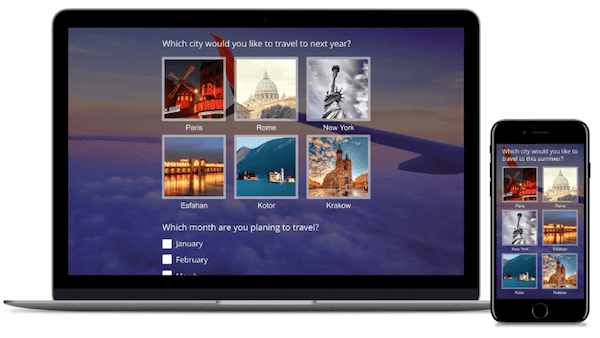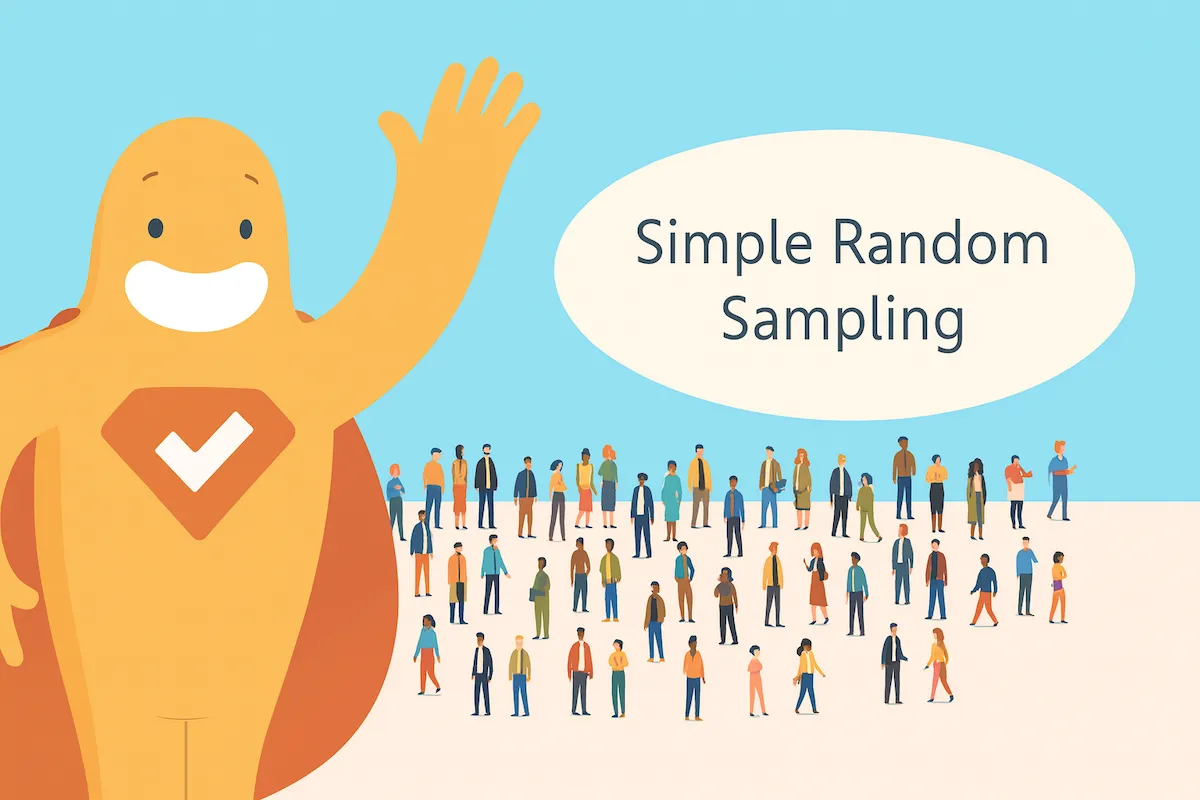The advantages of online surveys have revolutionized data collection, offering fast, affordable, and efficient ways to gather insights from large, diverse audiences. Compared to traditional methods like phone or mail surveys, they deliver higher accuracy, faster response times, and lower costs. Online tools also enable engaging designs with visuals, branding, and responsive layouts that improve participation and honesty. However, they’re not without drawbacks—limited access for offline users, potential survey bias, and a lack of interviewers can impact results. Still, with thoughtful design and balanced question types, the advantages of online surveys—speed, flexibility, and scale—far outweigh the disadvantages.
Create your online survey, form, or poll now!
Do you have a question you’d like insight into? A survey can get you the answer! Many businesses use surveys for gathering feedback and insights. While surveys have long been a popular way to gather research, today’s online survey tools have made surveying more popular than ever.
Surveys offer researchers quantitative and qualitative data that can be studied and analyzed, and provide companies with insight into various aspects of their business. Online surveys have many advantages over traditional methods, including greater efficiency, speed, and effectiveness in gathering feedback. So, let’s take a look at the benefits of online surveys (which far outweigh the negatives, which we’ll also cover).
The Popularity of Online Surveys
The majority of surveys used to be conducted in person or via telephone or by mail. A telephone survey is a method of data collection conducted via phone calls, either with live interviewers or through participant-initiated contacts. While these methods of surveying are still employed, the majority of today’s surveys have gone digital since just about everyone is online these days.
According to Sage, the number of surveys being conducted over the internet has increased dramatically in the last 10 years due to the relatively low cost of conducting web surveys in comparison with other methods. Online surveys offer faster response times, lower costs, and reduced biases compared to traditional surveys, such as paper-based or telephone surveys, making them a superior alternative.
For example, the U.S. Census Bureau conducts more than 130 surveys and programs each year, and that’s just one of the largest online surveys. Today, companies frequently use email surveys, pop-up surveys, website surveys, and other forms of questionnaires to collect customer feedback.
Create your online survey, form, or poll now!
14 Advantages of Online Surveys
What makes online surveys so popular? Online surveys help save money by eliminating the need for hiring surveyors, making them a cost-effective alternative to traditional methods. They are also highly effective for collecting data from a diverse audience, allowing you to reach a broad and varied demographic with ease. We’ve put together a list of reasons they’re so in demand, and to be fair, we also include a couple of reasons why another form of surveying may be in your best interest.
1. Faster
The time it takes for someone to complete an online survey is, on average, about two-thirds shorter than that of other research methods. Since online surveys are being taken automatically, there’s no need to wait for paper questionnaires to come back or for a phone interviewer to compile their findings. In addition, with web-based surveys, response time is almost instant.
This speed allows organizations to receive quick feedback from participants, enabling them to understand audience reactions promptly and make rapid decisions.
2. More Accurate
The margin of error is greatly reduced with online surveys because participants enter their responses directly into a web survey. Some traditional methods rely on the attentiveness of interviewers to enter all details correctly, and naturally, human error can creep in whenever a person has to perform a repetitive task. When it comes down to it, web surveys are usually more accurate. Since respondents record their own answers, there is no opportunity for an interviewer to misinterpret a response. Online surveys also eliminate the need for manual data entry, as respondents’ answers are automatically stored and processed, further reducing errors and improving data quality.
3. Branding Opportunities
An online photo survey is a chance to brand yourself and leave an impression on participants. You can style your survey to match your business website with custom backgrounds, logos, images, fonts, and more. Photo surveys and picture polls are also a great way to test new branding or gauge consumer reaction to a potential rebranding effort.
4. Visually Engaging
They say a picture is worth a thousand words, and it’s true! Adding survey pictures to your questionnaire is crucial for increasing participant engagement. With SurveyLegend, you can easily add visuals to online surveys, creating eye-catching surveys. You can adjust, rearrange, and resize survey pictures to suit your survey needs. There are many benefits to creating a survey or poll with pictures. Survey pictures can:
- Trigger feelings and emotions
- Improve memory and recall
- Communicate ideas more clearly
- Cross language barriers
- Improve response rates and data accuracy
The SurveyLegend picture survey below, shown responsively on both desktop and mobile, demonstrates just how engaging it can be to ask questions with pictures. Learn more about image-based surveys.
Create your online survey, form, or poll now!
5. More Honest
When a survey participant is speaking with a live interviewer, they may not be totally honest with their responses; they may outright lie. An online survey is easily made anonymous or confidential, not collecting the name or other easily identifiable information about the respondent. Therefore, many participants feel more comfortable and more likely to answer questions honestly. Online surveys encourage honest responses, especially when dealing with sensitive topics, because participants do not have to provide their answers directly to an interviewer.
6. More Flexible
The order of the questions in an online survey can be changed, or questions can be skipped altogether, depending on the answer to a previous question, to tailor the survey to each participant as he or she proceeds. Online surveys are also flexible. Unlike paper surveys, which have to be reprinted if/when errors arise, web-based surveys can be easily modified with just a few keystrokes. Similarly, they can be altered according to the demographics of the population being questioned, making it easier for companies to target specific audiences. This flexibility allows organizations to reach specific demographics by tailoring online surveys to gather insights from defined groups based on their characteristics and preferences, ensuring more relevant and actionable data.
7. Cost-Effective
Online surveys don’t have the expense of an interviewer for in-person or telephone surveys, the printing and postage required for mail-in surveys, and other costs associated with other means of surveying.
8. Anytime, Anywhere
This is an easy one; with online surveys, participants can take a survey at any time, no matter where they are. They also have the flexibility to complete the survey at their own pace, making it more convenient and comfortable for respondents. With a mobile-responsive design, they can take a survey on a subway at 3 AM! This means there’s no need to place expensive phone calls or send representatives on long-distance trips.
Create your online survey, form, or poll now!
9. Large Sample Sizes
Online surveys have a greater reach than other types of market research techniques. Too often, companies may make the mistake of assuming a small sampling of people represents the consensus. Underrepresentation of a portion of the population in polls is largely thought to be a big contributing factor to the surprise outcome of the 2016 U.S. presidential election. With online surveying, thousands of participants are within reach, allowing you to expand your sample size to extract data that matches the attributes of the larger population, getting you more conclusive results. Online surveys can help attract more respondents, but it’s important to note that a large portion of potential participants may overlook or dismiss surveys due to digital noise and limited attention spans.
10. Easy Data Analysis and Reporting
Surveys tend to be standardized, providing quantifiable data that can be easily compiled and analyzed. While qualitative survey research techniques, such as focus groups or phone interviews, may yield some interesting answers, analyzing responses becomes more difficult (and potentially inaccurate). In addition, many online survey programs offer advanced statistical tools that can be used to analyze survey data to determine validity, reliability, and statistical significance. Online surveys also help ensure reliable data by automating data collection and minimizing human error, which supports making informed decisions based on accurate and actionable insights.
11. No Interviewer
You’ll find this in the disadvantages, too, but not having an interviewer can also be a plus. An interviewer could cause a survey participant to hide their truth out of embarrassment or fear. The absence of interviewers changes the survey process by removing potential biases introduced by human interaction, but it can also impact the quality of responses since there is no one to clarify questions or encourage participation. Interviewees can also influence responses in some cases by their spoken language or body language, which skews survey results.
Create your online survey, form, or poll now!
12. More Candid Responses
Honesty is important in data collection; otherwise, your analysis and the action(s) you take may skew in one direction or another. Whereas in-person or telephone surveys can cause a person to “clam up” or be untruthful with their answers, most online surveys offer anonymity, which is more likely to result in people giving their true thoughts and feelings on any given subject.
This anonymity also enhances qualitative data collection, as online surveys can gather open-ended and candid responses that provide deeper insights into participants’ perspectives.
13. Responsive Design
Today, more and more people are accessing the internet (and taking surveys) using their smartphones. A good survey tool like SurveyLegend will include responsive design, which automatically adjusts surveys to make them render perfectly across any device. That means that mobile device users have a good experience as well!
Answering surveys on a computer or mobile phone can affect both the survey experience and the quality of data collected. For example, open-ended questions may be easier to answer on a computer, while mobile phones offer greater accessibility and convenience for respondents.
14. Easy To Use for Participants
Today’s consumers hate unsolicited phone calls. In addition, most don’t like junk mail and likely don’t have time for a face-to-face interview. That’s why online surveys are so great! So, with an online survey, participants can pick a moment that suits them best, and the time needed to complete the survey is much shorter. And, questions that are not relevant to a particular participant can be skipped automatically using SurveyLegend Skip Logic. However, it’s important to avoid long surveys, as they can cause participant fatigue and lower completion rates.
Create your online survey, form, or poll now!
Four Disadvantages of Online Surveys
There are many benefits of using online surveys for your marketing or company research. Online surveys are especially valuable for measuring customer satisfaction and gathering feedback from your audience, helping businesses improve their products and services. However, it wouldn’t be fair not to point out a few disadvantages.
1. Online Limitations
Not everyone has internet access. If you’re trying to survey a broad spectrum of people, you may miss out on the thoughts or opinions of older demographics and rural dwellers by using an online survey only. This occurred in 1948 when telephone surveys were used to poll for the presidential election, but researchers failed to recognize that many voters didn’t yet have telephones.
2. Close-Ended Question Limitations
Most surveys have closed-ended questions, meaning the respondent has no choice but to select an answer or choose “not applicable” or “other.” Multiple-choice and multiple choice questions are commonly used in online surveys as a type of closed-ended question, helping to streamline data collection and analysis by providing respondents with predefined answer options. While close-ended questions make surveys easy to analyze, they may have a lower validity rate than other types of questions (you can, of course, create surveys with open-ended questions).
3. Non-Response Bias
Survey fraud is probably the heaviest disadvantage of an online survey. Some people answer online surveys for the sake of getting the incentive (usually in the form of money) after they have completed the survey, not with a desire to contribute to the advancement of the study. Non-response bias and survey fraud can negatively impact the response rate of online surveys, making it harder to obtain accurate and reliable data. Read more in our blog: Different Types of Survey Bias and How to Avoid Them.
Create your online survey, form, or poll now!
4. No Interviewers
While sometimes considered a benefit, the lack of an interviewer can sometimes be a negative aspect of online surveys. That’s because a skilled interviewer can often coax answers out of a participant who isn’t very forthcoming with their responses. A skilled interviewer also knows how to read body language and can often tell when a participant is being untruthful as well as adjust questions to make an uncomfortable participant feel more at ease.
Conclusion
There are several methods of conducting a survey; it’s just a matter of determining which is right for you and which will garner the most accurate responses based on the questions you ask. Each of the following can be an effective survey method:
- In-person interviews
- Telephone surveys
- Focus groups
- Paneling sampling
- Mail-in surveys
- Kiosk surveys
- Online surveys
You can read more about all five of these types of surveys for research in our blog, 7 Different Types of Survey Methods. SurveyLegend offers a variety of types and styles of surveys, beautifully rendered and pre-designed, and responsive on any size screen, along with real-time analytics that will give you an insane amount of insight. Using online survey platforms and survey platforms makes it easy to conduct online survey research and distribute online questionnaires efficiently, with features like automation, built-in analytics, and multi-channel distribution.
You can check out some of our survey examples and templates now, or contact us to learn more or to find out how much it costs to conduct a survey (hint: it’s not much, and we’ve got some great deals going on now, too!).
Any advantages of online surveys that we missed? What do you like most about web-based surveys? Let us know in the comments below!
Create your online survey, form, or poll now!
Frequently Asked Questions (FAQs)
What are online surveys?
An online survey is a structured questionnaire that your target audience completes over the internet, generally by filling out questions on the web or a software program. Online surveys are commonly used for collecting data and gathering feedback from target audiences.
What are the different types of survey methods?
There are five main survey methods: in-person interviews, telephone surveys, mail-in surveys, kiosk surveys, and online surveys.
How can I conduct an online survey?
To conduct an online survey, use an online survey platform such as SurveyLegend.




